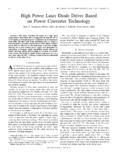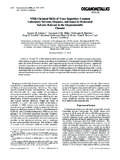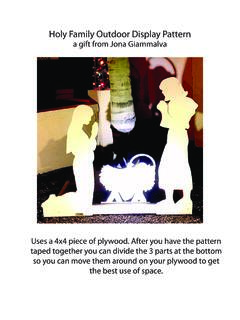Transcription of Inductance Calculation Techniques --- Part II ...
1 THOMPSON: Inductance Calculation Techniques --- Part II: Approximations and Handbook Methods Power Control and Intelligent Motion, December 1999, website Marc T. Thompson, 1999 file: 4/26/01 12:16 PM Page 1 of 11 Inductance Calculation Techniques --- Part II: Approximations and Handbook Methods Marc T. Thompson, INDEX OF SYMBOLS A Area enclosed by coil a Coil mean radius b Coil axial thickness c Coil radial thickness D Side length of square coil d Wire-to-wire spacing K Nagoaka coil constant l Coil length p Perimeter enclosed by coil P, F Grover disk coil constants R Circular wire radius s Side length of generic polygon w trace width x, y Mean side lengths of rectangular coil o Magnetic permeability of free space 4 10-7 H/m I. INTRODUCTION In the second part of this two part series on Inductance Calculation Techniques , approximation Techniques and handbook methods are shown for air-core structures that do not easily lend themselves to closed-form solutions.
2 A set of references is also given which is useful for finding the Inductance of many different loop shapes. Included are Inductance calculations for polygons, disk coils, finite-length solenoids and flat planar spirals. In some cases results are given without significant explanation, as the calculations are very complicated and the full calculations may be found in the references given. Many of the older references work out Inductance problems in English units; to ease design these results have been converted to MKS units with Inductance in Henries and length scales in meters. II. REFERENCE REVIEW Inductance Calculation references necessarily start with Maxwell's seminal work [1], first published in 1873. Maxwell worked out some interesting Inductance problems, including finding the mutual Inductance between circular coaxial filaments [1, pp.]
3 339], and finding the size and shape of a coil which maximizes Inductance for a given length of wire [1, pp. 345]. 1 The author is an independent consultant at 25 Commonwealth Road, Watertown Massachusetts, USA 02472. Business phone: (617) 923-1392. Fax: (617) 923-8762. Website: Email: and is Adjunct Associate Professor of Electrical Engineering, Worcester Polytechnic Institute, Worcester, MA 01609 THOMPSON: Inductance Calculation Techniques --- Part II: Approximations and Handbook Methods Power Control and Intelligent Motion, December 1999, website Marc T. Thompson, 1999 file: 4/26/01 12:16 PM Page 2 of 11 A seminal reference for Inductance Calculation (which, unfortunately is now out of print) is the Frederick Grover book [2].
4 Professor Grover spent most of his professional life calculating Inductance of different kinds of wire loops, and many useful examples and tables are given for loops of interesting shapes and sizes. The reference is especially useful as it gives correction factors to account for high frequency operation and other effects such as the insulation thickness of wires. He was also a consultant for the Bureau of Standards, and the results of some of his work are found in [3]. The Wheeler references [4,5] give simple results for circular coils, and are particularly useful where analytic expressions are needed. The empirically-derived analytic expressions in [5] are remarkably accurate for multiple-turn, circular coils. Another good reference is the Radio Engineers' Handbook, edited by Terman [6].
5 This reference shows the Inductance of many different coil shapes such as single-turn loops, rectangles, multiple-layer coils, and solenoids of various lengths. The Dwight reference [7] is very useful for calculating high-frequency effects in inductors, and covers skin and proximity effects. The Roters reference [8] shows a useful method by which leakage Inductance in transformers can be estimated. The Smythe reference [9] is a great work covering classical field and Inductance calculations. Solenoid Magnet Design [10] by D. Bruce Montgomery, covers design aspects of solenoid-shaped coils from a superconducting magnet point of view. Thermal aspects of inductor design are well covered here. Other references, as needed, are given in the text. A more comprehensive bibliography of Inductance Calculation references is given on the author's business website, given in the REFERENCES section.
6 III. APPROXIMATE AND CLOSED-FORM RESULTS FOR COMMON STRUCTURES 1. Circular Wire Loop The self- Inductance of a straight conductor of length l and radius R, neglecting the effects of nearby conductors ( assuming that the return current is far away) is given by [2, pp. 35]: 432ln2 RllLo [1] Many other magnetic structures can be modeled as simpler structure, since Inductance is in general a weak function of loop shape for loops with loop radius much larger than wire cross section. Surprisingly, there is no closed-form solution for the Inductance of a filamentary loop (since the expression for Inductance blows up if the wire radius goes to zero). A circular loop of round wire (Figure 1) with loop radius a and wire radius R has the approximate low frequency Inductance [2, pp.]
7 143], [4]: LaaRo= [2] Using this formula, the Inductance of a 1 meter circumference loop of 14 gauge wire is H; for 16 gauge wire it's H; and for 18 gauge wire it's H. Note the weak dependence of Inductance on wire diameter, due to the natural log in the expression. THOMPSON: Inductance Calculation Techniques --- Part II: Approximations and Handbook Methods Power Control and Intelligent Motion, December 1999, website Marc T. Thompson, 1999 file: 4/26/01 12:16 PM Page 3 of 11 A crude approximation for circular loops is L o a [11, pp. 56] which predicts an Inductance of H for a 1 meter circumference wire loop. a2R Figure 1. Circular wire loop 2. Parallel-wire line For two parallel wires whose length l is great compared to their distance d apart, (Figure 2) the Inductance of the loop is [2, pp.
8 39]: LldRdlo=+ ln14 [3] For l = meter and a wire-wire spacing d = 1 cm, results are: L = H for 14 gauge; L = H for 16 gauge and L = H for 18 gauge. Therefore, for the parallel-wire line with closely-spaced conductors, the Inductance is approximately microHenries per meter of total wire length. Rd Figure 2. Parallel-wire line 3. Square loop The self Inductance of a square coil made of rectangular wire (Figure 3), with depth b (into the paper) small compared to side length D and trace width 2w is a complicated expression found in the Zahn reference [12, pp. 343]. However, for w << D a relatively nasty expression can be approximated by: LDDwo 211 sinh () [4] For instance, a square PC board trace 1cm 1cm with trace width 1 millimeter has an Inductance of approximately 16 nanoHenries (assuming that the ground plane is far away, of course).
9 THOMPSON: Inductance Calculation Techniques --- Part II: Approximations and Handbook Methods Power Control and Intelligent Motion, December 1999, website Marc T. Thompson, 1999 file: 4/26/01 12:16 PM Page 4 of 11 DD2w Figure 3. Square coil with rectangular cross section 4. Rectangle of round wire The Inductance of a rectangle of round wire with rectangle side lengths x and y is [2, pp. 60]: LxxRyyRxyxxyyyxxyo= + ++ + lnlnsinhsinh. ()2221752211 [5] 5. Polygon of round wire These results suggest an interesting result for a polygon of wire. The Inductance of a generic polygon of wire with perimeter p and area A may be approximated by: LppRpAo + [6] Note that this function is strongly dependent on the perimeter and weakly dependent on loop area and wire radius.
10 For this reason, the Inductance of complicated shapes can often be well approximated by a simpler shape with the same perimeter and/or area. No closed-form exists to calculate the Inductance of a generic polygon of wire. Grover [2, pp. 60] has worked out a variety of cases for polygons with side length s and wire radius R: Equilateral Triangle LssRo= 32115546 ln. [7] Square LssRo= 20 52401 ln. [8] Pentagon LssRo= 520 15914 ln. [9] Hexagon LssRo= + 30 09848 ln. [10] Octagon LssRo= 40 03802 ln. [11] However, it is found in practice [2, pp. 61], [15] that the Inductance of a multi-faced polygon may be approximated by replacing a polygon by a simpler plane figure of either THOMPSON: Inductance Calculation Techniques --- Part II: Approximations and Handbook Methods Power Control and Intelligent Motion, December 1999, website Marc T.







